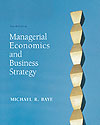 |  Managerial Economics and Business Strategy, 4/e Michael Baye,
Indiana University - Bloomington
Managing in Competitive, Monopolistic, and Monopolistically Competitive Markets
Chapter Summary In this chapter, we examine managerial decisions in three
market environments: perfect competition, monopoly, and monopolistic competition.
Each of these market structures provides a manager with a different set of variables
that can influence the firm's profits. A manager may need to pay particularly
close attention to different decision parameters because different market structures
allow control of only certain variables. Managers who recognize which variables
are relevant for a particular industry will make more profits for their firms.
Managers in perfectly competitive markets should concentrate
on producing the proper quantity and keeping costs low. Because perfectly competitive
markets contain a very large number of firms that produce perfect substitutes,
a manager in this market has no control over price. A manager in a monopoly,
in contrast, needs to recognize the relation between price and quantity. By
setting a quantity where marginal revenue equals marginal cost, the manager
of a monopoly will maximize profits. This is also true for the manager in a
monopolistically competitive market, who must also evaluate the firm's product
periodically to ensure that it is differentiated from other products in the
market. |
|




 2002 McGraw-Hill Higher Education
2002 McGraw-Hill Higher Education